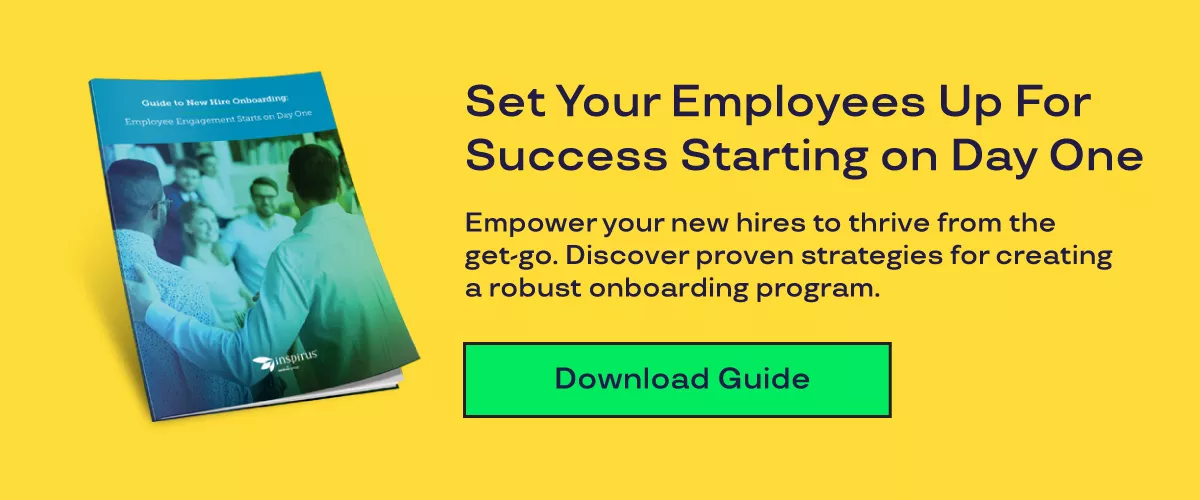
Employee Onboarding Plan - Navigating the Path to Future Employee Engagement
February 9, 2024
When an employee joins your organization, they’re virtually a blank slate. They represent an opportunity to mold them into a highly engaged, productive, and loyal members of your team.
That opportunity, though, can be lost if the onboarding process isn’t designed to nurture engagement and ensure that the employee feels they made a great choice in joining your team.
There is an undeniable correlation between onboarding and future employee engagement. Here we’ll take a look at the importance of employee onboarding, its impact on engagement, and how to create an effective onboarding plan to ensure your employees are engaged and on board for many years to come.
What is Employee Onboarding?
Employee onboarding is the process of introducing new employees to your company, their new role, their colleagues, and others they will interact with. It’s a process that can extend over many months and, in truth, a process that really should continue throughout an employee’s tenure with your organization. The goal of employee onboarding is to provide new employees with the information, tools, and resources they need to do their jobs effectively in support of overall organizational goals and objectives.
A comprehensive employee onboarding process typically involves several stages. It starts with pre-boarding, which begins at the point when an employee accepts a job with your organization. Then, the first day on the job, which is a critical point where first impressions are made. Those first impressions can lead to engagement—or disappointment. Next comes orientation where employees learn about the company and its key policies. Then comes training where employees learn how to perform their specific jobs. The process concludes with a performance stage where employees are making meaningful and measurable contributions.
Effective onboarding has a significant impact on an employee's experience and the organization's success. For instance, organizations with effective onboarding have 33% more employees feeling engaged compared to those without. Moreover, companies with standardized onboarding procedures experience 62% greater new hire productivity and 50% greater new employee retention.
Why is Employee Onboarding so Important?
Employee onboarding can make or break their relationship with your organization and those they will be working with. Done well it will lead to motivated, engaged, and highly productive employees. Done poorly, and you’re likely to face higher levels of dissatisfaction, and turnover, and poor performance.
Engaged employees are more likely to stay with your organization, to perform better, and to contribute to positive organizational results and a strong culture. Effective onboarding leads to:
- Enhanced collaboration and teamwork. Work gets done through teams that can collaborate to achieve mutual goals. Onboarding helps employees form these connections quickly and successfully.
- Improved transparency and accessibility of information. Information shared during onboarding, including access to that information through technology and digital resources, ensure employees have the support they need to do their jobs effectively.
- Increased productivity and efficiency. There are ample studies to support the impact onboarding can have on business outcomes.
- Facilitation of remote work and distributed teams. Today’s workforces are increasingly hybrid. Onboarding can help employees make connections with each other, regardless of where they may individually be doing their work.
Effective onboarding also contributes to a strong company culture.
Why Employee Engagement Matters for your Company Culture
Employee engagement is the extent to which employees feel passionate about their jobs, are committed to the organization, and are willing to put forth discretionary effort to get things done. When employees feel positively connected to their work and the people they work with they’ll perform better—and the organization will benefit from their contributions.
Improved retention rates and reduced turnover are significant benefits of employee engagement, as engaged employees are more likely to feel satisfied and stay with the company longer. Engagement also enhances productivity and performance. When employees are engaged, they are more motivated to perform their best, leading to improved business outcomes. An effective onboarding plan will serve to not only introduce new hires to their roles but also to quickly foster a culture of engagement which will lead to commitment and loyalty.
Benefits of An Employee Onboarding Plan to Boost Engagement
An onboarding process that quickly helps new employees feel welcomed and part of a strong company culture boosts engagement and sets them up for continued success. Effective onboarding is about more than simply introducing them to their roles. It’s about ensuring that new employees quickly feel a sense of belonging and are integrated into the culture. That sets them up for success and paves the way for future engagement.
In fact, employees are 69% more likely to stay with a company for three years if they experience a great onboarding process. What does that look like? Examples of successful onboarding include creating a time and space for new hires to understand the company culture and making connections. A boot camp program for new employees in leadership roles, for instance, might rotate employees through every team in the company, giving them an opportunity to learn how these teams operate and helping them develop strong personal ties with other team members.
Ways to Create an Effective and Engaging Onboarding
There are a number of best practices that companies can implement to boost the odds that their onboarding program will be both effective and engaging. For instance:
- Assign them a mentor. This should be someone other than their supervisor or manager—another employee who can serve as a role model and be a resource for the new employee as they learn about their job and the company.
- Schedule a team lunch or activity to help build connections. Offering opportunities for employees to meet and socialize with their colleagues is a good way to help them feel welcome and to build a strong internal network.
- Facilitate regular check-ins. It’s important to check in regularly with new employees to see how they’re doing, if they have any questions, or if they have recommendations on how the onboarding process might be improved to better meet their needs.
- Encourage new employees to contribute ideas and to take on bigger, long-term projects. Engagement is all about impact. Give employees the opportunity for impact by inviting their ideas and encouraging them to raise their hands to take on new challenges.
Seek additional ideas from employees about what they like, and recommendations they might have to strengthen your onboarding program. Onboarding should be an inclusive and iterative process that continually seeks feedback from those going through the process, as well as from managers and supervisors.
Frequently Asked Questions:
What are the 5 C's of employee onboarding?
The 5 C’s of employee onboarding generally refer to compliance, clarification, culture, connection, and check back.
What are the 4 C's of employee onboarding?
The 4 C’s of employee onboarding generally refer to compliance, clarification, culture, and connection.
How do you keep employees engaged during onboarding?
Keeping employees engaged during onboarding involves several strategies including communicating the company's mission, vision, and values from day one and helping new hires feel connected to the company's "why."
What are the 4 phases of employee onboarding?
The 4 phases of employee onboarding are pre-boarding, orientation, training, and integration.
What are the three pillars of onboarding?
The three pillars of onboarding are orientation (introducing new hires to the company and its culture), integration (helping new hires become part of the organization), and communication (an ongoing process to boost engagement and productivity).
How to design onboarding to improve employee engagement?
Onboarding can be designed to improve employee engagement by using a holistic approach customizing onboarding to individual employee needs, inviting their feedback and evaluating the impact of onboarding on business processes and outcomes.
What is an onboarding checklist?
An onboarding checklist is a tool used to help ensure that all of the key steps in the onboarding process are completed. These steps typically include things like competing paperwork, gaining access to tools and resources, being introduced to key colleagues and stakeholders, and completing training.
What is the most important employee onboarding activity?
The most important step in employee onboarding is communication, and it should be both ongoing, and two-way.
Conclusion
An effective onboarding process is crucial for integrating new hires into the organization’s culture, setting them up for success, and fostering relationships and engagement. With the right resources and tools, organizations can create an onboarding experience that is a holistic process that not only introduces new employees to their roles, but that also fosters a culture of engagement, loyalty, and longevity. Importantly, it’s a process that must incorporate continuing improvement and adaptation to react to both internal and external changes and changing employee needs and interests.





